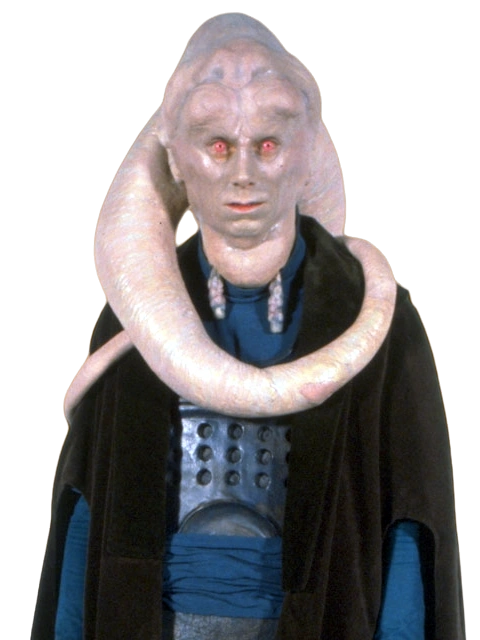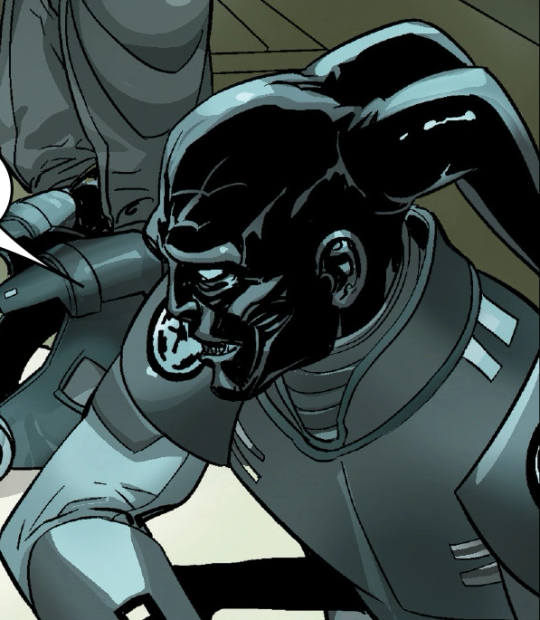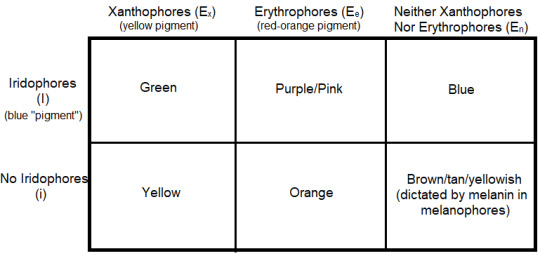#it would be interesting to see a pkorian (very rare secluded species with bright red skin)/melanistic-lethan twilek hybrid
Explore tagged Tumblr posts
Text
@dragonheartftherpays hope you don't mind me adding on with some rarer colors of Twileks:
Nat Secura (Star Wars 1998 comic) was the first to come to mind: skin tone wise, he seems to have a similar situation as Lyn Me, plus some dark spots around his upper face and lekku. He also has a pretty extensive known family (Aayla is his cousin, plus his dad and uncle Lon and Pol Secura, all of whom are medium-dark blue with light eyes).


left: Nat Secura; right: father Lon Secura
Given that the Secura family are all pretty dark blue (compared to, say, Orn Free Taa) I'm assuming that the dark bluish spots are his 'natural' color (which is actually kind of close to a purple). So based off this he would be En-I with partial leucism causing the lighter parts of his skin, and the unaffected areas showing up as blue patches/spots.
For Bib Fortuna, I looked at Wookiepedia and apparently he has a cousin Beezer Fortuna, who has light eyes and pale beige skin with dark stripes. I also haven't found any other white Twileks with pink tinted skin (most of them have a noticeable yellow/grey or blue/purple tint, which I'll mention later on), so between that and the red eyes, he's probably albino.


left: Bib Fortuna [?? albino]; right: Beezer Fortuna [EnEnii]
The other main family of white Twileks is Clan Fenn (Star Wars 1998 comic), featuring Ro and Kh'aris Fenn. Ro is drawn either with a yellow or greyish-beige tint, while Kh'aris is pale grey or pure white.



left: yellow Ro Fenn [EnEnii]; center: beige/grey Ro Fenn; right: Kh'aris Fenn [EnEnii]
Overall, it seems like the differentiation with white Twileks seems to be based off their tint: a yellow or grey/beige tinted phenotype is low-melanin EnEnii, blue, purple, or green tint is leucism (since iirc leucism doesn't affect the iridophores), and pink tint/red eyes is albinism.
Regarding black Twileks, I did find Tualon Yaluna (Darth Vader 2017), who is apparently a canon Jedi/Inquisitor, and probably melanistic:

Tualon Yaluna [?? melanistic]
For the red mutations, it seems like it's most likely to be option 4 (xanthophore mutation) given that there is one example of partial red pigmentation, notably in an Ex-i Twilek.

Ayy Vida [Ex-i partial xanthophore mutation]
Twi’lek Skin Color Genetics
Hello naughty children, a few weeks ago I spent five hours or so hashing out how Twi’lek skin color works genetically, and now I’m here to make that everyone’s problem. This is going to be a very long post, so I do apologize for that, feel free to hit J on desktop to skip. But it’s interesting, and it’s actually worked for every canon Twi’lek family I’ve tried it for so far (not that there are many to try), so here we go!
And yes, I made APA citations for this. Because I’m a nerd.
How Does Twi’lek Skin Pigmentation Work, Anyway?
Because it’s not as simple as humans. After all, Twi’leks come in a huge range of colors. The first challenge I had to deal with was figuring out how exactly Twi’lek skin coloration works in terms of pigmentation, before I could even start to figure out the genetics behind that.
See, in Earth mammals, most if not all pigmentation comes from melanin. Melanin comes in two forms, eumelanin (black/dark brown) and pheomelanin (reddish), and between the two of them in various concentrations melanin can produce colors ranging between black, brown, gray, red, yellow, and tan (Douma 2008).
Problem: Twi’leks, obviously, come in a lot more colors than that. See, mammals don’t generally produce blue or green pigments. However, you know what does produce green and blue colors? Reptiles and amphibians.
(No, I’m not suggesting Twi’leks are reptiles or amphibians, put that pitchfork down. They can hybridize with Humans, I think it’s pretty solidly canon that they’re mammals.)
So how do reptiles and amphibians produce blue and green colors? Well, instead of their coloration being based solely on melanin like us, many reptiles and amphibians have cells called chromatophores, cells containing certain types of pigments. Chromatophores generally come in three layers, from top to bottom: xanthophores, which contain yellow pigments called pteridines, iridophores, which don’t contain a true pigment but instead contain platelets which reflect mostly bluish light through physical structure and thus act as a blue “pigment,” and melanophores, which produce melanin. The topmost layer can also contain erythrophores, which contain reddish-orange/orange pigments called carotenoids (aka the reason you’re always told that if you eat enough carrots you can turn orange). Between differing amounts of each of these cells and their respective pigments, the three layers of chromatophores can produce a wide array of colors (Douma 2008).
Wide enough to cover all known wild type (naturally occurring, without mutation or intentional genetic manipulation via breeding) Twi’lek skin colors? Let’s find out.
Thanks to Wookieepedia, we do have a list of canon colors Twi’leks can come in, although I take issue with some of them (Twi’lek 2020).
Known wild-type colors: blue, green, tan/pale, orange, pink, purple, teal, yellow Known mutations: Albinism, leucism, red (erythrism?), vitiligo
Cosdra seems to have vitiligo, but it might be paint - it’s hard to tell (Cosdra 2019). Technically, since pink/red eyes do exist as a wild type in Twi’leks, it’s possible Bib Fortuna isn’t actually albino and just happens to have white skin and red eyes, but given how rare white skin seems to be and how he’s portrayed, I’m assuming him to be albino (Bib Fortuna 2020). Leucism, partial loss of pigmentation that most often results in white skin/hair/fur and dark eyes, is also a guess, technically speaking. We see what appears to be leucism in Lyn Me, with “true white” skin and dark eyes, but it’s not confirmed officially; however, due to how rare white skin seems to be, I am comfortable assuming Lyn Me to be an example of a leucistic Twi’lek (if she isn’t, she may instead be an EnEnii genotype with very little melanin production, as discussed later) (Lyn Me 2020).
Wookieepedia claims Twi’leks can have black skin, but it doesn’t have a citation, and I took the time to click through the entire list of canon Twi’lek characters and didn’t find a single black-skinned Twi’lek (”true black,” not dark-skinned). If a Legends character exists with “true black” skin, I feel comfortable assuming that to be an example of a melanism mutation or something similar, rather than a wild type color morph, due to its rarity.
Red being labeled a mutation is interesting, and I believe it’s technically Legends instead of strictly canon material, but I also didn’t find any counterexamples in canon, which leads me to believe it may as well be considered canon (Lethan 2020). I’ll talk more about the “true red” color mutation later in this post.
For now, we have a list of wild type skin colors. Can chromatophores, with variation between the various pigment cells, account for all the different colors Twi’lek skin can take on?
The answer is yes.

I didn’t take the time to chart out a hypothetical melanophore variation chart, since in most phenotypes how much of each type of melanin is present merely affects the saturation and brightness of the dominant color. Anyway, I imagine melanophore genetics would be more similar to human skin color genetics to begin with.
But Dragon, I hear you ask, I don’t see teal on this chart! Patience. We’re getting there. Because in order to talk about teal skin color, we have to talk about the actual genetics - teal comes from two incompletely dominant alleles being expressed together, rather than being a trait with its own allele.
So let’s get into the genetics, then!
The Genetics Behind It All
I’m going to put the Punnett square hell I went through beneath a cut at the bottom of this post for anyone who’s interested in seeing my evidence for this conclusion, and for everyone else I’m just going to put my conclusions.
I’ve assigned each allele an abbreviation, although they don’t display properly on Tumblr because I don’t know how to do subscript and superscript or if Tumblr supports that in the first place:
Ex: Xanthophores (yellow pigment) present. Ee: Erythrophores (reddish-orange/orange pigment) present. En: Neither xanthophores nor erythrophores present/both nonfunctional.
I: Iridophores (blue “pigment”) present. i: Iridophores not present/nonfunctional.
For the purposes of figuring out this system, I actually used a hybrid family, the Lawquanes.

Wait, hold on, why a hybrid family? Well, first off because they’re the ones who started all this, because someone pointed out how the hell did a pink mom and Human dad end up with a teal-and-tan child and an orangey-tan child? So I wanted to answer that question in a way that also fit any other canon Twi’lek families.
However, using this family had another advantage, as I quickly realized: because Cut Lawquane, the father of the children, is Human, we know his genotype for the purposes of the relevant first two layers of chromatophores: he doesn’t have them. He’s homozygous for both non-expression traits: EnEnii. That simplified figuring out the genotypes of the children and his wife a ton - in fact, I’m not sure it would have been possible to extrapolate those answers, if not for the fact that we know his genotype for these traits 100% for certain.
So without putting you through the whole process, this is what I came to:
Suu Lawquane (mother): EeExIi (pink phenotype) Cut Lawquane (father): EnEnii (tan/melanin-only phenotype) Shaeeah Lawquane (daughter): ExEnIi (teal phenotype*) Jek Lawquane (son): EeEnii (orange/tan phenotype**)
* I’m not dealing with the patching Shaeeah has going on because I’m assuming that’s an effect of hybridization on her phenotype, since we haven’t seen markings like that on any canon full-blood Twi’leks. I’m assuming teal to be her “base” phenotype as far as Twi’lek genes go, since teal obviously isn’t a color we see in Humans. ** I’m genuinely not sure whether to call that skin color orange or tan, nor do I know whether Ee or En is dominant or if they even have a simple dominance relationship - more on that in a moment - so I’m leaving that be. The point stands.
So these are the rules of dominance we end up with:
1. I (iridophores present) is dominant over i (no iridophores present/functional). Evidence: Suu Lawquane must be heterozygous Ii in order to have produced both a teal (I phenotype) and tan/orange (i phenotype) child with her homozygous ii husband. Furthermore, Shaeeah would be yellowish-tan if i were dominant over I, since she must be heterozygous due to having a homozygous ii father and yet displaying the I trait as her phenotype.
2. Ex and En are incompletely dominant with each other. Evidence: this is how you get teal children, a mix between blue (EnEn) and green (ExEx). An EeEx x EnEn pairing is capable of producing an ExEn child (Shaeeah), which tracks with this logic.
3. Ee (erythrophores present) is dominant over Ex (xanthophores present). Evidence: Suu Lawquane must be heterozygous EeEx in order to have produced both a teal (ExEn phenotype) and an orange/tan (Ee and/or En phenotype) child with an EnEn husband while still displaying the Ee phenotype (pink) herself. Since she displays a strong Ee phenotype and must also have an Ex allele, the Ee allele must therefore be dominant over the Ex allele.
These rules can be applied to other Twi’lek families, as well - for instance, the Syndullas (not counting Jacen Syndulla, both because he wouldn’t be an interesting addition due to his Twi’lek influence being Also A Green Phenotype and because I will never forgive Rebels for that horrible boring hybrid design) work out to:
Cham Syndulla: EeExii (orange phenotype) Tislera Syndulla: ExExIi or ExExII (green phenotype, not enough data to prove conclusively whether she’s heterozygous Ii or homozygous II) Hera Syndulla: ExExIi (green phenotype)
Because En and Ex are incompletely dominant, neither Tislera nor Hera can be ExEn, and they must be homozygous ExEx because Ee is dominant over Ex. Because Ee is dominant over Ex and his daughter must be homozygous Ex, Cham must therefore be EeEx, showing the Ee phenotype but carrying the recessive Ex allele which he passed on to his daughter.
There is one small problem: We still don’t know for sure the relationship between Ee and En. I just don’t have enough data to figure it out. I went through the entire list of canon Twi’lek characters on Wookieepedia and didn’t find a single family with the right color combinations and enough data to figure it out. I even went through some Clone Wars crowd shots in hopes of finding some, only to discover that apparently the Clone Wars series doesn’t really use child models in their crowd shots, only adults. Maybe someday I’ll go through the entire list of Legends Twi’lek characters in hopes of finding a family with the right genetics to solidify my guesses, but for now, all I have to go on is how common various phenotypes are. Which isn’t perfect, because how common a trait is doesn’t necessarily have anything to do with whether it’s dominant or recessive if it’s an advantageous trait, but it’s all we have. My current hypothesis is that En is dominant over Ee, because blue and tan are both more common phenotypes than purple and orange, but that wouldn’t hold up to the standards of biology by any stretch of the imagination. I simply don’t have enough data to give you a better answer, unfortunately. Maybe some of the new media coming out, like the High Republic series, will give me that - I don’t know. They might not even have a simple dominance relationship; they might be incompletely dominant with each other like Ex and En are, producing bluish-purple, though I find this unlikely given the phenotypes we’ve seen in Star Wars media thus far.
So Why is Red Skin a Mutation?
It’s an oddly specific thing to be labeled a mutation, because you’d think it would just be a variation of the Ee-i phenotype, which normally produces orange or reddish-orange. In order for this to make sense, we have to assume one of two scenarios:
a) Erythrophores in Twi’leks are typically more orange than red, or b) The melanin produced in orange Twi’leks (the Ee-i phenotype) prevents a “true red” from showing as the final skin tone.
In the first option:
1) True red is produced by an erythrophore mutation that causes the carotenoids produced to be more red than normal.
In the second option:
2) True red is produced by a lack of melanin, leaving the final visual color completely dependent on the red/reddish-orange carotenoids rather than mellowing it to orange, or 3) True red is produced by a mutation in the melanophores that cause them to produce only a very red pheomelanin with no eumelanin to balance it out.
Alternatively to both of these:
4) True red is produced by a mutation in the xanthophores in a Twi’lek lacking iridophores (the Ex-i phenotype), causing them to produce a true red pigmentation rather than the yellow pteridines they would normally produce.
Even in Legends, as far as I could find, we don’t have any families of Lethan Twi’leks (Twi’leks with the true red mutation), so I have no evidence to support any of these possibilities (Lethan 2020). However, in any of these cases, the mutation would be rare, not only because the genetic mutation itself is rare, but also because it must occur simultaneously with a specific set of other conditions to produce the true red coloration: 1) and 2) must occur in conjunction with the Ee-i phenotype (and in the case of 1, presumably with melanin that’s light enough to not obscure the true red coloration), 3) must occur either with the Ee-i or En-i phenotype, and 4) must occur in conjunction with the Ex-i phenotype. Since I is dominant over i and seems to be the more common trait, that helps explain why the true red mutation(s) is/are so rare.
Bonus: Why Do Twi’leks Come In So Many Colors, Anyway?
(This section is entirely conjecture and headcanon on my part.)
Because, really, most species tend to consolidate until they’re almost identical color-wise, because the environment tends to select for a given color scheme. However, there are instances in which this is not the case. Personally, my headcanon explanation for this is that Twi’leks as a species tend to have a preference for the unique - if you’re the only person in a group with your skin color (or some other notable physical characteristic), you’re more likely to be found attractive than if you’re in a group of people with the same skin color (or other physical characteristic). This is a form of negative frequency-dependent selection, in which the fitness of a given trait or genotype decreases as it becomes more common (Frequency-Dependent Selection 2020). Negative frequency-dependent selection is itself a form of balancing selection, which serves to actively maintain multiple alleles in a population rather than selecting preferentially for one trait (Balancing Selection 2020).
(What’s the evolutionary advantage behind finding the unique attractive? Who knows. But the point is, it is feasible, and negative frequency-dependent selection is something we see out in the real world.)
In Conclusion
In conclusion, it turns out there actually is a system that works consistently to predict the genotypes and phenotypes of Twi’lek families, with the small exception of not having enough data to determine the dominance relationship in one out of the four allele pair relationships yet. If you know of a canon or Legends Twi’lek family, feel free to try to apply this! If it doesn’t seem to work, feel free to poke me about it, and I’ll see if I can make it work - if I can’t, I’ll have to take another look at the system. (Heck, apply it to your own OCs and see if it works, if you want - or use it to predict offspring traits of various pairings, if you like.) I learned a good bit about chromatophores and pigmentation in animal biology while doing this, and I hope you enjoyed the ride and maybe learned something too. Reblogs are always appreciated if you enjoyed yourself, found this interesting, or learned something! Thank you for reading! (And don’t forget, if you’re interested in reading about the process of how I figured all this out, the screenshots of that are below the cut!)
References
Bib Fortuna. (2020, April 4). In Wookieepedia: the Star Wars Wiki. Retrieved April 20, 2020, from https://starwars.fandom.com/wiki/Bib_Fortuna.
Balancing Selection. (2020, April 18). In Wikipedia. Retrieved April 20, 2020, from https://en.wikipedia.org/wiki/Balancing_selection.
Cosdra. (2019, September 9). In Wookieepedia: the Star Wars Wiki. Retrieved April 20, 2020, from https://starwars.fandom.com/wiki/Cosdra.
Douma, M., curator. (2008). Biological Pigments. In Cause of Color. Retrieved 30 March 2020 from http://www.webexhibits.org/causesofcolor/7I.html.
Frequency-Dependent Selection. (2020, April 15). In Wikipedia. Retrieved April 20, 2020, from https://en.wikipedia.org/wiki/Frequency-dependent_selection.
Lethan. (2020, April 13). In Wookieepedia: the Star Wars Wiki. Retrieved April 20, 2020, from https://starwars.fandom.com/wiki/Lethan
Lyn Me. (2020, April 4). In Wookieepedia: the Star Wars Wiki. Retrieved April 20, 2020, from https://starwars.fandom.com/wiki/Lyn_Me.
Twi'lek. (2020, April 20). In Wookieepedia: the Star Wars Wiki. Retrieved April 20, 2020, from https://starwars.fandom.com/wiki/Twi%27lek.
Keep reading
#star wars#genetics#twileks#long post#nat is ... interestingly colored#its probably not a 'natural' twilek patterning thing#since all other examples of twilek patterns show up around the lekku and sometimes shoulders (hera; eleni; aayla; lunae minx)#and are generally pretty round or even#all the fortunas look uh. inbred#legends lists two other fortunas; only one of whom has an associated picture (komad fortuna)#hes from the kotor era and looks pretty normal (does not have the giant overly pointy crest and wattles)#also is it just me or is kharis fenn somewhat gnc? i don't think ive seen male twileks wearing the zigzag style lek wraps and ear covers#and usually not the full head cover thing either#given that lethans are supposedly 'one in a million'#but a full half of all sith twileks are lethan (darths talon; ruyn; atroxa; luft)#im going to assume yaluna is melanistic lethan#which is. ExExii (all recessive) plus rare xanthropore mutation plus melanism mutation#too bad vader killed him and his gf#it would be interesting to see a pkorian (very rare secluded species with bright red skin)/melanistic-lethan twilek hybrid#would their children look like Dathomirian Twileks#op i hope you dont mind me tagging you#this was really fun to read#hopefully my thing is coherent i wrote this at like 2am
947 notes
·
View notes